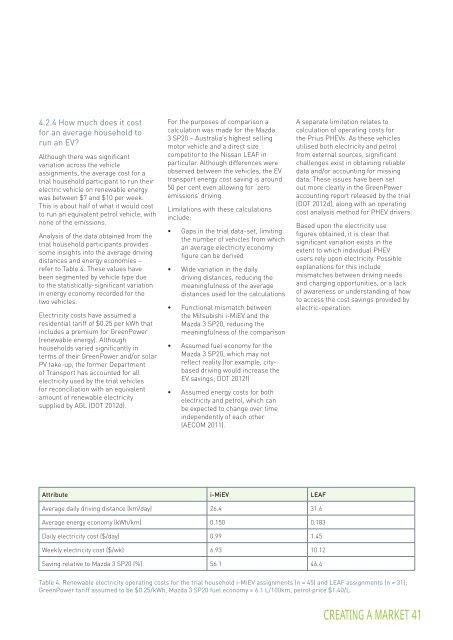victorian electric vehicle trial mid-term report - Department of Transport
victorian electric vehicle trial mid-term report - Department of Transport
victorian electric vehicle trial mid-term report - Department of Transport
- No tags were found...
Create successful ePaper yourself
Turn your PDF publications into a flip-book with our unique Google optimized e-Paper software.
4.2.4 How much does it costfor an average household torun an EV?Although there was significantvariation across the <strong>vehicle</strong>assignments, the average cost for a<strong>trial</strong> household participant to run their<strong>electric</strong> <strong>vehicle</strong> on renewable energywas between $7 and $10 per week.This is about half <strong>of</strong> what it would costto run an equivalent petrol <strong>vehicle</strong>, withnone <strong>of</strong> the emissions.Analysis <strong>of</strong> the data obtained from the<strong>trial</strong> household participants providessome insights into the average drivingdistances and energy economies –refer to Table 4. These values havebeen segmented by <strong>vehicle</strong> type dueto the statistically-significant variationin energy economy recorded for thetwo <strong>vehicle</strong>s.Electricity costs have assumed aresidential tariff <strong>of</strong> $0.25 per kWh thatincludes a premium for GreenPower(renewable energy). Althoughhouseholds varied significantly in<strong>term</strong>s <strong>of</strong> their GreenPower and/or solarPV take-up, the former <strong>Department</strong><strong>of</strong> <strong>Transport</strong> has accounted for all<strong>electric</strong>ity used by the <strong>trial</strong> <strong>vehicle</strong>sfor reconciliation with an equivalentamount <strong>of</strong> renewable <strong>electric</strong>itysupplied by AGL (DOT 2012d).For the purposes <strong>of</strong> comparison acalculation was made for the Mazda3 SP20 – Australia’s highest sellingmotor <strong>vehicle</strong> and a direct sizecompetitor to the Nissan LEAF inparticular. Although differences wereobserved between the <strong>vehicle</strong>s, the EVtransport energy cost saving is around50 per cent even allowing for ‘zeroemissions’ driving.Limitations with these calculationsinclude:• Gaps in the <strong>trial</strong> data-set, limitingthe number <strong>of</strong> <strong>vehicle</strong>s from whichan average <strong>electric</strong>ity economyfigure can be derived• Wide variation in the dailydriving distances, reducing themeaningfulness <strong>of</strong> the averagedistances used for the calculations• Functional mismatch betweenthe Mitsubishi i-MiEV and theMazda 3 SP20, reducing themeaningfulness <strong>of</strong> the comparison• Assumed fuel economy for theMazda 3 SP20, which may notreflect reality (for example, citybaseddriving would increase theEV savings; DOT 2012f)• Assumed energy costs for both<strong>electric</strong>ity and petrol, which canbe expected to change over timeindependently <strong>of</strong> each other(AECOM 2011).A separate limitation relates tocalculation <strong>of</strong> operating costs forthe Prius PHEVs. As these <strong>vehicle</strong>sutilised both <strong>electric</strong>ity and petrolfrom external sources, significantchallenges exist in obtaining reliabledata and/or accounting for missingdata. These issues have been setout more clearly in the GreenPoweraccounting <strong>report</strong> released by the <strong>trial</strong>(DOT 2012d), along with an operatingcost analysis method for PHEV drivers.Based upon the <strong>electric</strong>ity usefigures obtained, it is clear thatsignificant variation exists in theextent to which individual PHEVusers rely upon <strong>electric</strong>ity. Possibleexplanations for this includemismatches between driving needsand charging opportunities, or a lack<strong>of</strong> awareness or understanding <strong>of</strong> howto access the cost savings provided by<strong>electric</strong>-operation.Attribute i-MiEV LEAFAverage daily driving distance (km/day) 26.4 31.6Average energy economy (kWh/km) 0.150 0.183Daily <strong>electric</strong>ity cost ($/day) 0.99 1.45Weekly <strong>electric</strong>ity cost ($/wk) 6.93 10.12Saving relative to Mazda 3 SP20 (%) 56.1 46.4Table 4. Renewable <strong>electric</strong>ity operating costs for the <strong>trial</strong> household i-MiEV assignments (n = 45) and LEAF assignments (n = 31);GreenPower tariff assumed to be $0.25/kWh, Mazda 3 SP20 fuel economy = 6.1 L/100km, petrol price $1.40/L.CREATING A MARKET 41
















